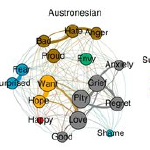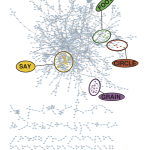Project: CLICS3: Database of Cross-Linguistic Colexifications

The original Database of Cross-Linguistic Colexifications (CLICS), has established a computer-assisted framework for the interactive representation of cross-linguistic colexification patterns. It has proven to be a useful tool for various kinds of investigation into cross-linguistic semantic associations, ranging from studies on semantic change, patterns of conceptualization, and linguistic paleontology. But CLICS has also been criticized for obvious shortcomings. Building on standardization efforts reflected in the CLDF initiative and novel approaches for fast, efficient, and reliable data aggregation, CLICS² expanded the original CLICS database. CLICS³ - the third installment of CLICS - exploits the framework pioneered in CLICS² to more than double the amount of data aggregated in the database.
Publications from this Project:
The Database of Cross-Linguistic Colexifications, reproducible analysis of cross-linguistic polysemies.

Rzymski C, Tresoldi T, Greenhill SJ, Wu M-S, Schweikhard NE, Koptjevskaja-Tamm M, Gast V, et al. 2020. The Database of Cross-Linguistic Colexifications, Reproducible Analysis of Cross-Linguistic Polysemies. Scientific Data 7 (1): 1–12.
Advances in computer-assisted linguistic research have been greatly influential in reshaping linguistic research. With the increasing availability of interconnected datasets created and curated by researchers, more and more interwoven questions can now be investigated. Such advances, however, are bringing high requirements in terms of rigorousness for preparing and curating datasets. Here we present CLICS, a Database of Cross-Linguistic Colexifications (CLICS). CLICS tackles interconnected interdisciplinary research questions about the colexification of words across semantic categories in the …
Abstract PDF 10.1038/s41597-019-0341-x OverviewEmotion semantics show both cultural variation and universal structure.

Jackson JC, Watts J, Henry TR, List JM, Forkel R, Mucha PJ, Greenhill SJ, Gray RD, & Lindquist KA. 2019 Emotion semantics show both cultural variation and universal structure. Science, 366, 1517-1522.
It is unclear whether emotion terms have the same meaning across cultures. Jackson et al. examined nearly 2500 languages to determine the degree of similarity in linguistic networks of 24 emotion terms across cultures (see the Perspective by Majid). There were low levels of similarity, and thus high variability, in the meaning of emotion terms across cultures. Similarity of emotion terms could be predicted on the basis of the geographic proximity of the languages they originate from, their hedonic valence, and the physiological arousal they evoke. Many human languages have words for emotions …
Abstract PDF 10.1126/science.aaw8160 OverviewCLICS2: An Improved Database of Cross-Linguistic Colexifications Assembling Lexical Data with Help of Cross-Linguistic Data Formats.

List J-M, Greenhill SJ, Anderson C, Mayer T, Tresoldi T & Forkel R. 2018. CLICS2: An Improved Database of Cross-Linguistic Colexifications Assembling Lexical Data with Help of Cross-Linguistic Data Formats. Linguistic Typology, 22: 277-306.
The Database of Cross-Linguistic Colexifications (CLICS), has established a computer-assisted framework for the interactive representation of cross-linguistic colexification patterns. In its current form, it has proven to be a useful tool for various kinds of investigation into cross-linguistic semantic associations, ranging from studies on semantic change, patterns of conceptualization, and linguistic paleontology. But CLICS has also been criticized for obvious shortcomings, ranging from the underlying dataset, which still contains many errors, up to the limits of cross-linguistic …
Abstract PDF 10.1515/lingty-2018-0010 Website